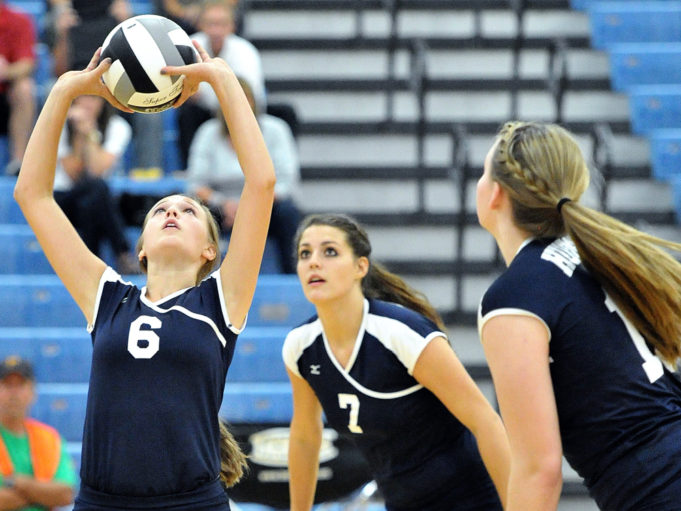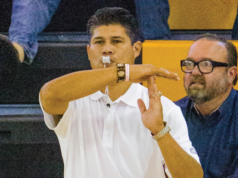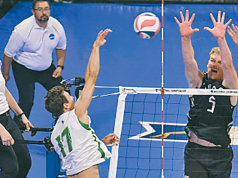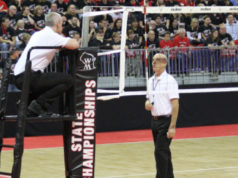A primary responsibility of the first referee is to determine whether a player makes legal contact each time he or she plays the ball. The referee must ensure the ball has not been held, caught and thrown or “over-controlled.” That means referees are making hundreds of judgment decisions in a single match. Ballhandling judgment is often considered the most important skill for a volleyball referee to master, similar to calling balls and strikes in baseball or softball.
Who decides?
Only the first referee can whistle ballhandling faults. When the second referee believes the first referee may have been screened from seeing a contact, he or she may indicate that opinion to the first referee using a discreet signal; however, the second referee cannot whistle to stop play and make that call.
The spin of the ball is not considered when determining the legality of the contact, nor should the referee consider the player’s body position, the technique used, or the sound of the contact.
To determine the legality of each contact, the first referee should lead the ball with his or her eyes, rather than follow the ball in the air. The referee should focus on the actual contact of the ball on the body part, then pick up the next play/player with his or her eyes.
When is a ball considered “held” or caught/thrown?
The various rules codes give specific guidance to help the referee judge whether the ball was legally played. NCAA and USAV rules state, “The ball must be hit cleanly and not caught or thrown. It can rebound in any direction” (USAV 9.2.2; NCAA 14.2.2). NCAA rules also include “prolonged contact with the ball is a fault.” NFHS (9-4-5) uses slightly different wording that says, “Legal contact is a touch of the ball by any part of a player’s body which does not allow the ball to visibly come to rest or involve prolonged contact with a player’s body.” A held or “caught and thrown” ball normally occurs when the player over-controls the ball. Any first team hit can be a multiple or double contact, but a double contact on a team’s second or third team hit is illegal. A caught/thrown or held ball is always illegal, whether it’s a block or the first, second or third team hit.
There are numerous playing actions that may result in prolonged contact with the ball or the ball being caught/thrown or held:
Forearm pass.
That is a common technique where players hold their arms together, forearms facing upward, to form a platform to pass the ball. It is often used during serve reception and when making other first team contacts. The ball is played legally when it rebounds quickly from the platform. When the player isn’t able to control the ball with a forearm pass, the ball may contact the player multiple times (i.e., rebounding from forearms then to the shoulder), or may roll up the player’s arms. In most situations, that play should not be considered a held ball if it occurs on the first contact where multiple contacts with the ball are allowed. However, it is a fault on a second or third contact where multiple contacts are illegal. A ball that quickly rolls up the arms and doesn’t visibly come to rest is generally not considered “held.”
A ball can be overcontrolled by a player using a forearm pass. When the player catches or stops the ball between his or her arms, a held ball has likely occurred.
Setting action.
A held ball may result when the ball is played using “setting action” (an overhand finger pass), and the player catches or holds the ball before releasing it. For example, when the setter’s intended hitter is late getting into position for the attack, the setter may be slow in releasing the ball, and a catch/throw or held ball may result.
Attacking the ball.
A held ball can occur if the player catches and throws the ball when attacking or “tipping” the ball across the net. It is legal for a player to use his or her fingertips to attack the ball, but the ball must be played without being caught, thrown or held.
Ball falling near the floor.
A held ball could result when a player is trying to play a ball that is very close to the floor by getting underneath the ball to prevent it from hitting the playing surface. A player may use a single, open hand in an attempt to keep the ball in play, and may catch the ball to prevent it from touching the floor. A ball is generally not caught/thrown or held if a player makes contact underneath the ball with an open hand provided the ball rebounds off the open hand.
Ball played out of the net.
That is a play that often results in referees automatically making a call when the ball was actually played legally. As long as the ball rebounds off the player, the referee should allow play to continue and not make a call based on the player’s body position or technique. A ball falling down the front of the net often rebounds slowly from a player’s arm(s) or hand(s) because it isn’t carrying much momentum. A slow rebound shouldn’t be confused with an illegal catch/throw.
Determining ballhandling legality is a skill all referees must learn. Regardless of a referee’s experience, it is an area that everyone can improve upon with practice. Strive for consistency, stay current with playing trends and techniques, and seek feedback from partners and fellow referees to help identify areas you can improve.
What's Your Call? Leave a Comment:
Note: This article is archival in nature. Rules, interpretations, mechanics, philosophies and other information may or may not be correct for the current year.
This article is the copyright of ©Referee Enterprises, Inc., and may not be republished in whole or in part online, in print or in any capacity without expressed written permission from Referee. The article is made available for educational use by individuals.


















